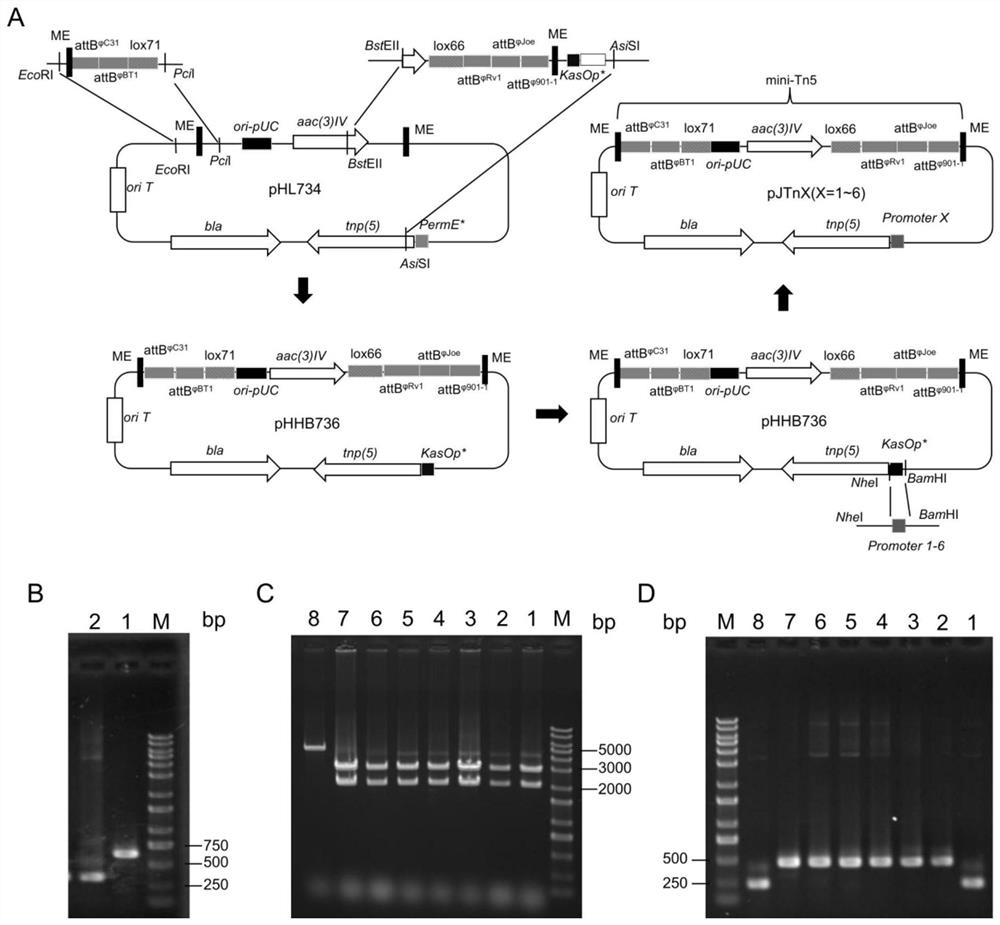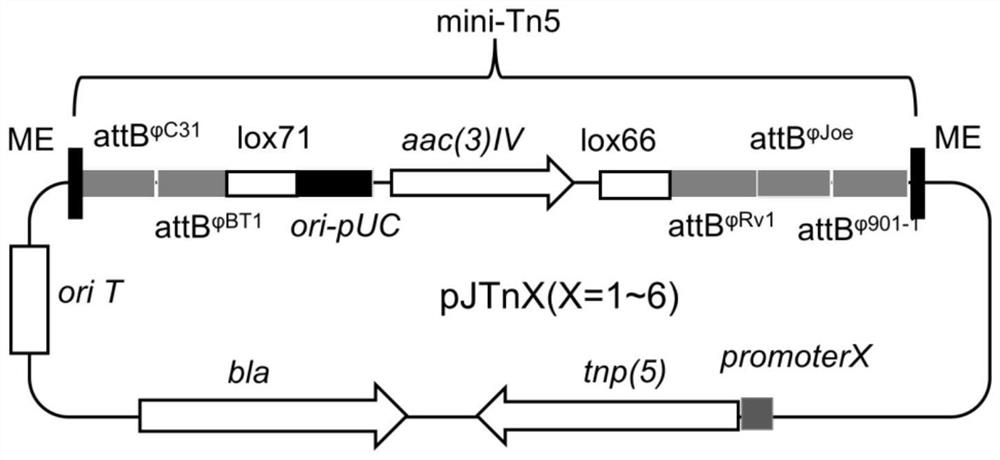Transposon plasmids for saccharopolyspora spinosa and application of transposon plasmisd
A technology of Saccharopolyspora spinosa and plasmids, which is applied in the field of genetic engineering, can solve the problems of cumbersome work, difficulty in obtaining random mutant strains, and no in vivo transposition mutagenesis system, and achieves the goal of simple method and high transposition efficiency Effect
- Summary
- Abstract
- Description
- Claims
- Application Information
AI Technical Summary
Problems solved by technology
Method used
Image
Examples
Embodiment 1
[0077] Embodiment 1, the construction of transposable plasmid
[0078] pHL734 is a Tn5-type transposition plasmid, with the inverted repeat sequence ME as the transposition boundary. The mini-Tn5 of this plasmid contains the E. coli replication origin site ori-pUC (SEQ ID NO.5) and apramycin The promoters of the resistance gene aac(3)IV (SEQ ID NO.6) and the transposase gene tnp(5)(SEQ ID NO.13) are the strong promoter PermE*. This plasmid has high transposition efficiency in Streptomyces coelicolor. pHL734 was constructed and preserved by our research group, in the literature "Zhong Xu, Yemin Wang, Keith F. Chater, Hong-Yu Ou, H. Howard Xu, Zixin Deng, Meifeng Tao; Large-Scale Transposition Mutagenesis of Streptomyces coelicolor Identifies Hundreds of Genes Influencing Antibiotic Biosynthesis. Appl Environ Microbiol. 2017 Mar 15; 83(6):e02889-16." It has been published, and the public can obtain it from the research group of Shanghai Jiao Tong University.
[0079] Gene sy...
Embodiment 2
[0081] Embodiment 2, improve the activity of transposase in the transposable plasmid, its promoter KasOP * Replaced with Saccharopolyspora Medium High promoter for constitutive expression
[0082] 1) In order to ensure the stable and efficient expression of the transposase gene in S. spinosa, the present invention screens out six constitutively expressed protein genes by analyzing the proteome data of S. spinosa, and selects these six genes The promoters of the six genes are used as the promoters controlling the expression of the transposase genes, that is, promoter1-promoter6. The functions of these six genes are shown in Table 2, and their corresponding sequences are shown in SEQ ID NO.17-22 in sequence.
[0083] Table 2. Sources of transposase promoters
[0084] transposase promoter source promoter1 superoxide dismutase[Fe-Zn]1(WP_010308738.1) promoter 2 superoxide dismutase[Fe-Zn]2(WP_101376528.1) promoter 3 cold-shock DNA-binding prot...
Embodiment 3
[0087] Example 3. Transposable plasmids were introduced into Saccharopolyspora rubrum by conjugative transfer to form transposable mutants
[0088] Saccharopolyspora erythraea (S.erythraea) NRRL23338 (the strain in "Oliynyk M, Samborskyy M, Lester J B, et al.Complete genome sequence of the erythromycin-producingbacterium Saccharopolyspora erythraea NRRL23338[J].NATURE BIOTECHNOLOGY,250 (4):447-453.", the public can obtain from the Peter Francis Leadlay laboratory) to carry out the transposition mutagenesis experiment for the recipient bacteria.
[0089] 1) The plasmids pHHB736, pJTn1, pJTn2, pJTn3, pJTn4, pJTn5, pJTn6 were electrotransformed into E.coliDH10B / pUZ8002, screened for resistance to apramycin and ampicillin, and verified by digesting the plasmids extracted from the transformants, Positive transformants E.coli DH10B (pUZ8002, pHHB736), E.coli DH10B (pUZ8002, pJTn1), E.coli DH10B (pUZ8002, pJTn2), E.coli DH10B (pUZ8002, pJTn3), E.coli DH10B (pUZ8002 , pJTn4), E.col...
PUM
 Login to View More
Login to View More Abstract
Description
Claims
Application Information
 Login to View More
Login to View More - R&D
- Intellectual Property
- Life Sciences
- Materials
- Tech Scout
- Unparalleled Data Quality
- Higher Quality Content
- 60% Fewer Hallucinations
Browse by: Latest US Patents, China's latest patents, Technical Efficacy Thesaurus, Application Domain, Technology Topic, Popular Technical Reports.
© 2025 PatSnap. All rights reserved.Legal|Privacy policy|Modern Slavery Act Transparency Statement|Sitemap|About US| Contact US: help@patsnap.com



